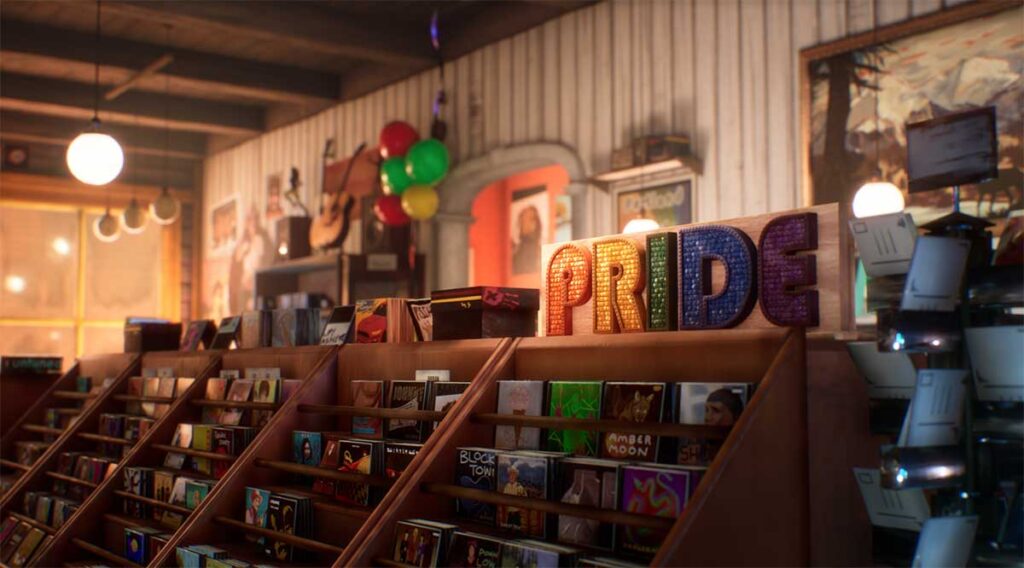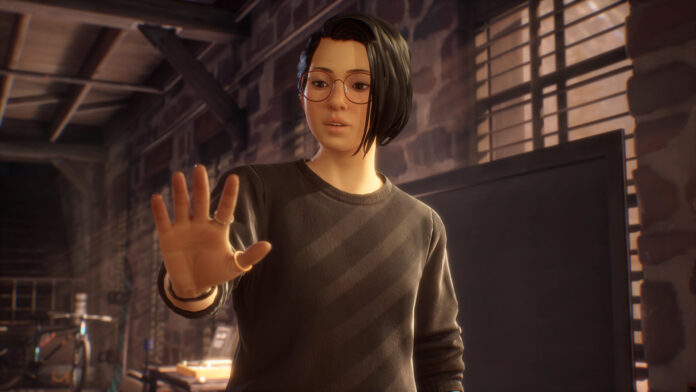“Home isn’t something you find, it’s something you build.” — Gabe Chen
One of the most beautiful aspects of gaming entertainment is the liveable story that players become a part of, and once in a blue moon, a game will break through with so much richness and viscerality that the humanness and characters within feel truly alive. “Life is Strange: True Colors,” out now for Playstation 4, Xbox One and other platforms, has broken through and asks players to make emotionally loaded and consequential decisions for the life of main character Alex Chen.
The newest edition to the “Life is Strange” universe has players using a superhuman sense of empathy to fight against environmental crimes. Taking place in a fictional Colorado town, Haven Springs, the player becomes Chen and uses empathy — sensing people’s emotions via the color of their aura — to uncover the truth about her brother’s death and in turn untangle the strings that have secretly controlled the town for generations. Alex can romance Steph Gingrich, Ryan Lucan, or no one at all — depending on the player’s choices — which impact the ending of Alex’s story.
With an original soundtrack from Angus and Julia Stone, and tracks from mxmtoon, Novo Amor, Gabrielle Aplin, Phoebe Bridgers, Fenne Lily, and more, it’s not only the gameplay that’s queer. And indie music-lovers will swoon when taken through the game’s central story, which features Alex performing songs including Radiohead’s “Creep” as well as tracks written specifically for the game.
Senior Staff Writer for “Life is Strange: True Colors” Felice Kuan, Voice Actor and Capture Artist Erika Mori (Alex Chen), and Voice Actor and Performance Artist Katy Benz (Steph Gingrich) sat down with PGN to answer some questions about “True Colors” and its additional downloadable content (DLC) “Wavelengths.”
First, I loved seeing six people on small-town queer Tinder when playing “Wavelengths.” Second, I rarely play games that I invest in emotionally, where I feel everything the characters feel. How are you inspired to create such vivid narratives?
Felice Kuan: I think how it’s delivered and presented, as well as animated, contributes to much of why people are resonating. But we do draw from ourselves as much as possible. With “True Colors,” we had the chance to illuminate the topics that are dear to our hearts, that we have a more personal connection to. You mentioned the dating app — that was entirely written by Deandra Warrock, and probably written from personal experience as well.
“True Colors” focuses on Alex’s neurodivergence and how it relates to empathy. What inspired you to write Alex’s character and her relationship to empathy?
Kuan: With this particular supernatural power [empathy] … it feels more like an analogy for something that people can go through in real life. Whether that is emotional processing, or any other kind of processing. Sort of repeating my prior answer, but we are constantly looking for the different facets of empathy and how it takes [Alex] over and how we personally relate to that.
Alex’s story is so heart-wrenching and inspiring. What was the most challenging part about playing Alex?
Erika Mori: I would say it was getting into those emotional spaces in a safe way and finding a technique that worked for me so that I wasn’t retraumatizing myself every time I needed to go really deep into fear or jealousy or different facets of grief. Similar to how the writers were drawing upon their own lived experiences, I was doing that too. I think good actors bring that to their performances, but because I didn’t have training, and I didnt have the technique when I first was cast, I was almost exclusively drawing on my personal lived experience. I knew very quickly that this was not going to work for me in a healthy way unless I found some techniques and training to help me go out onto those emotional limbs and come back to neutral. I actually talked about this a little on Katy [Benz]’s stream. Both of us have gone through and been trained in lucid body, which is a technique that specifically helps actors and performers find emotion located in their body and then come back to neutral — so that was very critical.
I automatically think of lucid dreaming. Can you elaborate?
Mori: At the highest level, different emotions can live in different parts of your body. When I feel a particular type of grief, I feel it really low in my torso, between my pelvis and my stomach, and there’s like a clenching and a turning that goes there. I’m feeling it now, just recalling that particular emotion… Being able to recognize, okay that’s where that particular emotion lives in my body, I now know where to access it, and that’s where you lead from in a scene or in a character interaction that requires you to draw on those emotions. Then you can put it away, and you can come back into your full body, and your full self. The lucid body technique really spoke to me because I have a really extensive dance background.
Katy, when I played the game I chose your character, Steph, as Alex’s romance. How did you connect with Steph? Are you a huge Dungeons & Dragons (D&D) fan?
Katy Benz: Well definitely I think for me, being able to be Steph in [2017’s] “Life is Strange: Before the Storm,” then having this entire four years between that, I’ve developed interests that Steph has. I’ve delved into D&D; I’d never played it before, but now I have. I think that diving into her interests helped me a lot with “True Colors” and with “Wavelengths.” I’m a streamer on Twitch, and my community is largely made up of the LGBTQ community. Having LGBTQ people [on Twitch] expressing how important it is for them to feel represented in a game — and in the back of my mind knowing that I’m working on this game and that Steph’s coming back (though I can’t tell them) — and having their input without them even knowing has helped me shape Steph in “True Colors.”

As a gamer yourself, how does it feel to be playing an LGBTQ gaming icon?
Benz: It’s amazing, as an ally I am just so honored. I’m honestly so honored that people trust me with Steph, I’m honored that Deck Nine has trusted me with Steph. It’s just a beautiful world with beautiful people in the community that strives to be seen and heard. I am grateful. That’s just my phrase, I use it all the time, but I truly am, to be able to represent such an important character in an important video game.
Is there going to be a “Life is Strange: Professor X”? Will these supernatural power-driven characters ever come together?
Kuan: We don’t know. Before we knew what we were going to do with “Wavelengths” definitively, we were thinking, “Oh, crossover!” We don’t know what’s ahead for the franchise, but we joke about it for sure.
How did “Life is Strange” being celebrated by LGBTQ people influence how you portrayed these characters?
Mori: Alex is bisexual, so I had to be able to play three different versions of the character: one where she is attracted to and going to romance Steph, one where she is going to romance Ryan, and one where she won’t romance anyone. There are different shades and nuances depending on the choices that you make. I will say that regardless of which choice anyone makes, Alex is wholly Alex. She holds her gender identity, her sexuality, whatever religion she is, her ethnicity, all within her naturally, in a similar way that we all do. It’s all just a part of her. How she chooses to express it in any given moment is really cool because it’s decided by the player.
Was it difficult to move between all of those identities?
Mori: You know, it wasn’t. I think the most challenging switching occurred in Chapter 5 because it took more prep to be like, “Okay, for this one line, this is the pinball of choices that a character would have made for Alex to say this. So remember in Chapter 1, they did this, then this, then this, then this. In Chapter 2 they did this..” and there might be two or three versions of that line with a slightly different musicality or vocabulary or cadence to it. It wasn’t difficult, but I’m so glad that creatives were holding all of those branching options in their heads so that they could just tell me what to do.
Benz: And you were in your apartment, too [when performing].
Mori: Yeah, I was in my house, I was in my basement.
So, when you’re going over the lines in this choose-your-own-adventure style narrative, I would assume it isn’t linear. How does time work when performing these roles during production?
Mori: It’s definitely not linear, especially because we’ll have pick-ups because the writers and the narrative team are building out future parts of the story as we’re filming. If they need to make tweaks, we have to go back and update that so there’s continuity. That was something to get used to, coming from theater or a theater background where you perform a whole story, there’s a beginning, middle and end that you can see, even if the play itself jumps around in time.
“Life Is Strange: True Colors” is available for purchase or download on various platforms. For more information, visit the game’s website.
